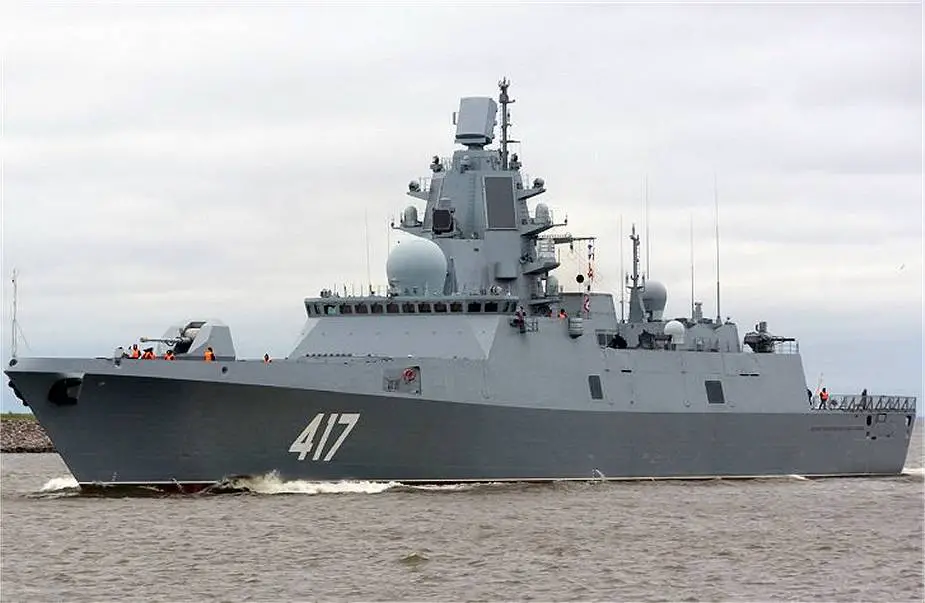Breaking news
State trials of Tsirkon hypersonic missile from Russian Navy Admiral Gorshkov frigate to start in June.
According to information published by the Russian press agency on May 20, 2021, the state trials of the Tsirkon hypersonic missile from the Russian Navy Project 22350 frigate Admiral Gorshkov will start in June 2021.
Follow Navy Recognition on Google News at this link
 Russian Navy Project 22350 frigate Admiral Gorshkov. (Picture source Twitter Defence and Technology)
Russian Navy Project 22350 frigate Admiral Gorshkov. (Picture source Twitter Defence and Technology)
“The first launch of the Tsirkon missile is planned to be performed from the Admiral Gorshkov frigate in June within the framework of its state trials,” a source said. According to the other TASS source, the Tsirkon missile is planned to be launched four times during its state trials.
The Machine-Building Scientific and Production Association integrated into the Tactical Missiles Corporation declined to comment on the information.
A source in the defense industry told TASS earlier that the Tsirkon hypersonic missile had successfully completed flight development tests on a ship. The flight development test program was fully executed in 2020. The Admiral Gorshkov frigate made three successful Tsirkon launches — two at sea and one at a ground target.
On April 20, Russian Defense Minister Sergei Shoigu said that the Tsirkon trials were planned to be completed in 2021.
On March 25, 2021, Navy Recognition has released news announcing a test launch of the Tsirkon hypersonic missile from the Project 22350 lead frigate Admiral Gorshkov.
The Admiral Gorshkov Russian designation project 22350 is a new class of frigates built by Severnaya Verf OJSC for the Russian Navy. The ship is designed to conduct anti-submarine warfare and escort operations. She was laid down on 1 February 2006 in Severnaya Verf shipyard in St. Petersburg and commissioned in 2018.
The Admiral Gorshkov is armed with one 130 mm Amethyst/Arsenal A-192M naval gun, 16 VLS (Vertical Launching System) cells able to launch Kalibr, Oniks or Zircon/Tsirkon anti-ship cruise missiles, 32 Redut VLS cells for 9M96, 9M96M, 9M96D/9M96DM(M2) and/or quad-packed 9M100 surface-to-air missiles, two Palash CIWS (Close-In Weapon Systems), eight 330 mm torpedo tubes for Paket-NK anti-torpedo/anti-submarine torpedoes and two 14.5 mm MTPU pedestal machine guns.
Several countries are developing hypersonic weapons, which fly at speeds of at least Mach 5 (five times the speed of sound). There are two primary categories of hypersonic weapons including Hypersonic glide vehicle which is launched from a rocket before gliding to a target and Hypersonic cruise missiles powered by high-speed, air-breathing engines. Hypersonic weapons could challenge detection and defense due to their speed, maneuverability, and low altitude of flight
The Tsirkonor Zircon is a Russian-made hypersonic missile designed to be launched by a ship and able to travel at speeds of between Mach 6 and Mach 8. The missile is reportedly capable of striking both ground and naval targets. According to Russian military sources, it has a range of between approximately 250 (400 km) and 600 miles (965 km) and can be fired from the vertical launch systems mounted on cruisers Admiral Nakhimov and Pyotr Veliky, Project 20380 corvettes, Project 22350 frigates, and Project 885 Yasen-class submarines, among other platforms.


























